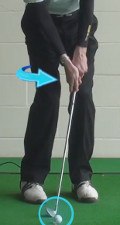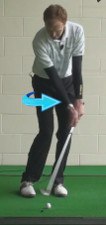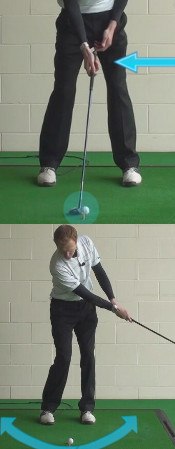
A ball perched high in the greenside rough can cause all sorts of problems. The worst case is when your club slides completely underneath the ball, failing to make contact. You've lost a stroke and been embarrassed in the process.
Fortunately, that's a rare and usually avoidable occurrence. But you must pay close attention to your lie and swing to ensure it doesn't happen.
First, check out the ball's position. Is it sitting up in the grass, at least an inch above ground level? If so, proceed with caution.

In these cases, the sand wedge is your best friend. The club's bounce means it's got a thicker bottom, so there's less chance of the blade slipping under the ball cleanly. Sand wedge in hand, here's how to handle a fluffy greenside lie:
- Place the ball back in your stance – right of center (for righties).
- Your hands should be ahead of the ball, the shaft leaning toward the target.
- Keep the clubface square or slightly open to the target.
- Make your normal chipping swing, being sure to hit down on the ball by keeping your hands ahead of the club. This will prevent you from cutting underneath the ball.
Don't try to be a hero in these situations. If you go for the fancy flop shot, you may end up whiffing the ball.

Fluffy Lie Basics – Short Game
When you miss the green with an approach shot, you really don't know what to expect as you walk up toward your ball. Are you going to draw a good lie, or will the ball be sitting down in the grass? What kind of path will you have available between your ball and the hole? There are more questions than answers as you walk up, but everything will soon become clear as you arrive at the shot. Sometimes, you get good news – the lie looks good and you have plenty of green to work with. On the other hand, you will sometimes arrive to find a nearly impossible shot. There is nothing you can do about the luck of the draw when it comes to short game shots, so your best bet is to be as prepared as possible for whatever may come your way.
One of the keys to being prepared in the short game is learning how to read your various lies as accurately as possible. If you can correctly predict what the ball is going to do when it comes out of the grass, you will have a much better chance of getting up and down. Some lies are obvious, such as a clean lie on the fairway grass or a lie which is buried down deep in the rough. However, some other lies are little trickier, as they can cause you to think the shot will be easier than actually is the case.
This is true of the lie that we are going to focus on in this article. A 'fluffy' lie is one where the ball is sitting up on the top of the grass. You will usually see this kind of lie on a golf course which features medium-length rough and a sturdy type of grass. Longer rough will usually let the ball fall to the bottom, so fluffy lies rarely appear on courses with long rough around the greens. You will know you have drawn a fluffy lie when you can see almost the entire ball sitting up on top of the grass. The ball itself is not actually resting on the ground – it is being suspended an inch or two above the ground by the strength of the grass.
Many golfers are fooled by this lie, thinking that it is a good thing. Since you can see the entire ball, and therefore you can get your club on the ball cleanly, you might think that it'll be easy to strike a solid shot and send the ball up toward the up. That is not the case. Yes, you will be able to get the club to the ball without a problem, but hitting a quality shot from this type of lie is far from a sure thing. In this article, we will offer you the advice necessary to deal with this shot properly. We aren't going to be able to take all of the challenge out of this situation, of course, but we'll give you the tools to have a fighting chance.
All of the content below is based on a right-handed golfer. If you happen to play left-handed, please take a moment to reverse the directions as necessary.

The Problem
If you know anything at all about reading the lie of the golf ball in various locations around the course, you know that the main concern is being able to get the club cleanly on the back of the ball. Usually, when you can put the club face on the ball without anything getting in the way, it will be possible to hit a good shot. So why is the story different here? There are a couple of problems which are going to make it difficult to come up with the kind of quality shot you need to get up and down.
The first problem is making contact on the sweet spot. Since there is air under the ball – just like if you were playing from a tee – it is possible to swing the club too far under the ball as you make contact. This will result in impact that takes place high on the face, and a shot which comes up short of the target. Of course, if you try to avoid that outcome, you may swing through impact too high, catching the ball low on the face and hitting it too hard. It's difficult to swing through at the perfect elevation to find the sweet spot. When the ball is on the ground, you don't have that concern. You just swing down into impact, take a little divot, and the ball will be at the right height for a clean strike.
The other notable problem with this kind of lie is the inability to put spin on the ball. Even though you will be able to place the club nicely on the back of the ball, you won't be able to generate spin because of the fact that the ball is up in the air. You can't pinch the ball against the turf, meaning it is going to come off with a very low backspin rate – too low to do anything for you once the shot lands on the green. If you would like to test this for yourself, try chipping a few shots off of a tee. Even if you catch the ball cleanly, you are unlikely to get much in the way of spin.
So, it is hard to control your distance on shots played from a fluffy lie, and it is also difficult to spin the ball effectively. As you can see, those two limitations are going to create some serious problems for you on the course. If you need to stop the ball quickly after it lands, you'll have to use height as spin is going to be off the table. Even then, hitting the ball high from this kind of lie is particularly dangerous – you can actually swing right under the ball without even making contact if you're trying to hit a flop shot.
In some cases, the best you will be able to do from a fluffy lie is just take your medicine and move on to the next shot. That might not be much fun – since it will often mean accepting a bogey as the inevitable result – but making a bogey is better than turning the hole into a complete disaster. If you try to hit a perfect shot and wind up failing to hit the green, you could suddenly turn your score into a double bogey or worse.
As we move on with this article, we are going to offer some technical tips which will help you get the best possible results from this type of lie. However, even once you have a good technique on your side, you are still going to want to play it safe most of the time. Don't try to do anything too spectacular from a fluffy lie, as you'll only be inviting trouble. Always err on the side of caution and you should be able to get through the hole with minimal damage to your scorecard.

Simple Technical Tips
You always want to use the best possible technique for the shot at hand when playing this game. It is not enough to have solid chipping technique – you need to have the right technique for the right shot. The standard chipping technique you use for a shot from a clean fairway lie is not going to be the same as the technique you use from a fluffy lie. Every shot you encounter on the golf course requires some degree of adaptation. This is why time spent learning the game on the course is almost always more valuable than time spent on the range. Sure, the range is a great place to learn technique, but there is only one place to learn how to get the ball in the hole – out on the course.
To make sure you are giving yourself the best possible chance at success from a fluffy lie, use the following tips.
- Keep your hands quiet. This is not the type of shot where you want to use your hands actively in the swing. It is important to keep your hands quiet while simply sweeping the club through the hitting area. This is the best way to approach the shot because you don't want to hit down on the ball. If you were to use much hand action, you'd wind up hitting with a downward angle of attack – and it's likely you would make contact with the ball too high on the club face. Think about keeping your hands and wrists almost completely out of the action while you just rock your shoulders to move the club. This is almost exactly the same way you swing your putter when on the greens. By replicating your putting action here with this type of chip shot, you should be able to achieve solid results.
- Use a long, smooth swing. You don't want to be accelerating rapidly when you come into impact, as that is likely to result in a shot which travels too far. Since there won't be much spin on the ball when it comes off the club, it is easy to hit this type of shot harder than you intended. To counteract that possibility, approach the shot with a long, smooth swing that is meant to just scoop the ball off the grass and toward the target. You don't want to be accelerating too much at impact, but you don't want to be losing speed, either. Work on using a longer-than-normal backswing for these kinds of chip shots and then carry a steady pace through the ball.
- Keep your head steady. Obviously, this is a tip that applies throughout your golf game. However, with specific regard to chipping from a fluffy lie, this is an important thing to keep in mind because you need to make the best-possible contact in order to judge your distance correctly. If you allow your head to move even a little before impact, it will be nearly impossible to strike the ball with the sweet spot of the club. Focus your eyes on a specific spot on the golf ball and hold them there until the ball is gone. It takes discipline to remain focused while swinging the club, but that discipline is likely to be rewarded in the form of a positive outcome.
You don't want to make your technique too technical for this specialty shot, as you are unlikely to encounter it on a regular basis. This is a shot you'll only need to play once in a while, which means your best bet is to keep things as simple and straightforward as you can. Use the tips above to put together your chipping technique for a fluffy lie and you'll be on the right track.






